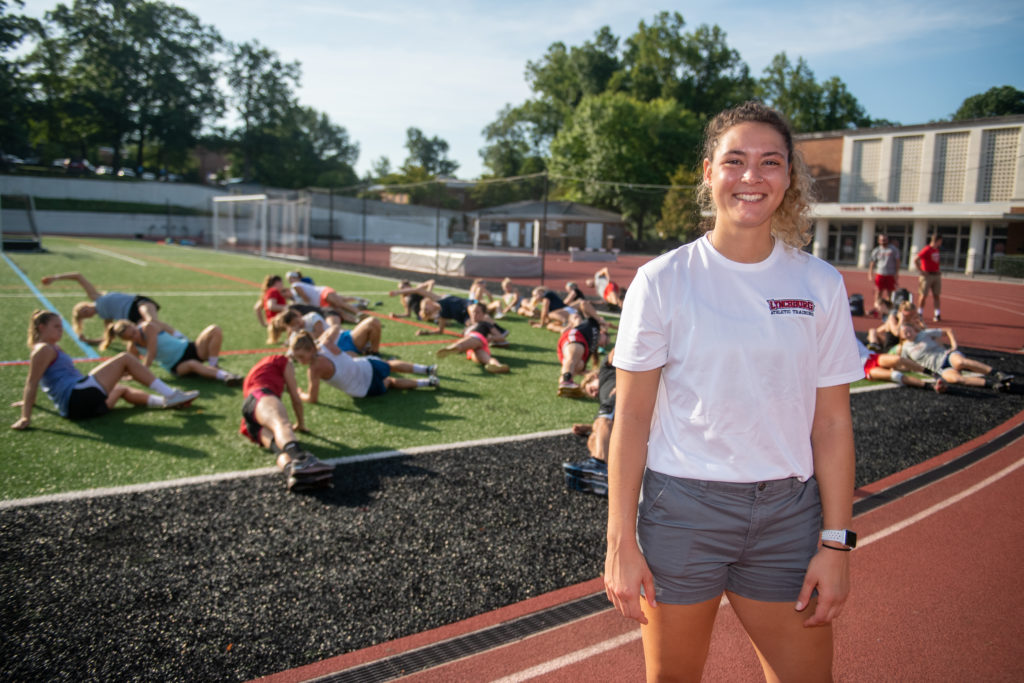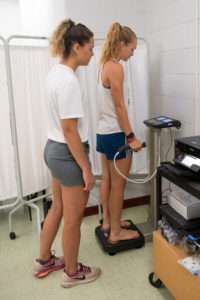On a hot August morning with a “feels like” temperature approaching triple digits, members of the University of Lynchburg women’s soccer team lined up in the athletic training room for a post-workout weigh in.
The athletes weren’t stepping on the scale in their sweat-soaked workout gear to see if they’d gained weight, but rather to see if they’d lost it. More specifically, Lexie Austin ’20 MSAT wanted to see how much weight the players had literally sweated out.
Too much and you might have to sit out the next practice.
“They need to hydrate,” Austin said a couple of days into preseason tryouts. “Until they gain the weight back, they can’t go back to practice. It hasn’t happened yet, but it can happen. What can happen is heat-related illness, heat stroke, heat exertion — and those things can lead to death.”

During the preseason, when athletes might practice two or even three times a day, Austin collected data for a study that involves tracking the workload and sweat rates of athletes.
Her research uses GPS technology and a bioelectrical impedance analysis scale that measures weight, body mass index, bone mass, fat percentage, muscle mass, and — most importantly for Austin’s research — total body water.
“The women’s soccer team and I are very excited that Lexie has chosen to conduct research on our team,” head women’s soccer coach Todd Olsen said. “It will be terrific to have evidence-based research completed to help us as we negotiate the challenges of preparing college athletes for competition, especially during the oppressive heat often found during preseason.
“From her results, we will be able to make evidence-based decisions on practice volume, as well as suggestions for our athletes on the most efficient methods for staying hydrated. This will reduce injuries among our athletes, allow for better recovery, and optimize performance.”

This is the second season the women’s soccer program has used GPS units, tucked into small pockets in the back of the athletes’ sports bras, to track activity during practice and games. It’s part of an ongoing effort to improve performance and reduce injuries.
“The measurement is known as the external load an athlete experiences and corresponds to the intensity and duration of the activities of practices and games,” Dr. Sean Collins, associate professor of exercise physiology, explained.
“Over time, these loads influence fatigue and increase injury risk, so we use this type of analysis to help manage player stress in order to ensure the greatest levels of performance while also attempting to reduce injury risks that come from fatigue.”
Collins, who also is the director of Lynchburg’s Walker Human Performance Laboratory, said Austin’s research expands on this.
“Lexie is taking this analysis a few steps further by examining how these loads affect the athletes’ physiology, specifically how these loads and the environment of Division III soccer preseason training affect the fluid loss leading to dehydration,” he said.
“Division III preseason is extremely short compared to other NCAA divisions, yet the athletes are still expected to perform at a high level for competitions only a few weeks away. So, what Lexie is trying to determine is how does the training during this time affect the hydration status of the athletes.”
Austin, who has a bachelor’s degree in exercise and sport science, said she initially thought she’d pursue physical therapy because, as she puts it, “I really liked the corrective exercise and rehab aspect.”
But as a former college volleyball player, she found herself drawn to athletic training. “I like working with athletes more than the geriatric population,” she said. “It fits into what I want to do with rehab and working with athletes. I’ve also been an athlete, so I feel like I can relate to them and I’m comfortable around them.”
When she’s finished with her research, Austin will share her findings with the Korey Stringer Institute, a group based at the University of Connecticut’s Department of Kinesiology. The mission of the Institute, named for an NFL player who died of exertional heat stroke in 2001, is to prevent heat-related illness and death in athletes, workers, and soldiers.
She also plans to submit her research to the National Athletic Trainers’ Association for possible inclusion in the NATA’s annual conference in June 2020.
Her research also will help Lynchburg’s soccer coaches, athletic trainers, and athletes have a successful and safe season. “Dehydration during practices and competition, especially in the heat, have health and performance risks that can lead to fatigue and injury,” Collins said.
“Understanding how external loads and the subsequent effect on athletes’ hydration status can help athletic trainers and coaches properly design training and prevention care initiatives in order to maintain healthy athletes through one of the more stressful parts of their season.”

